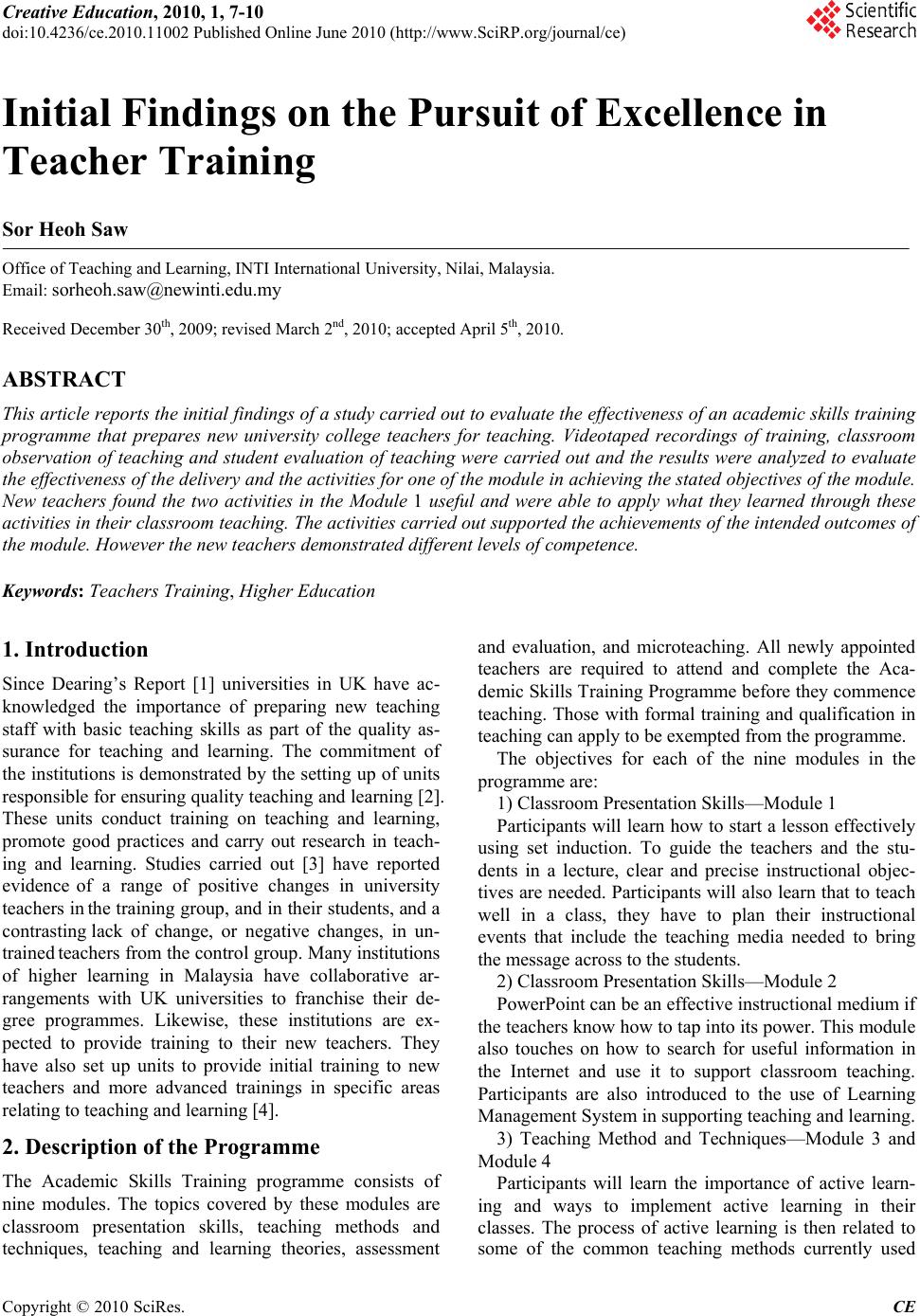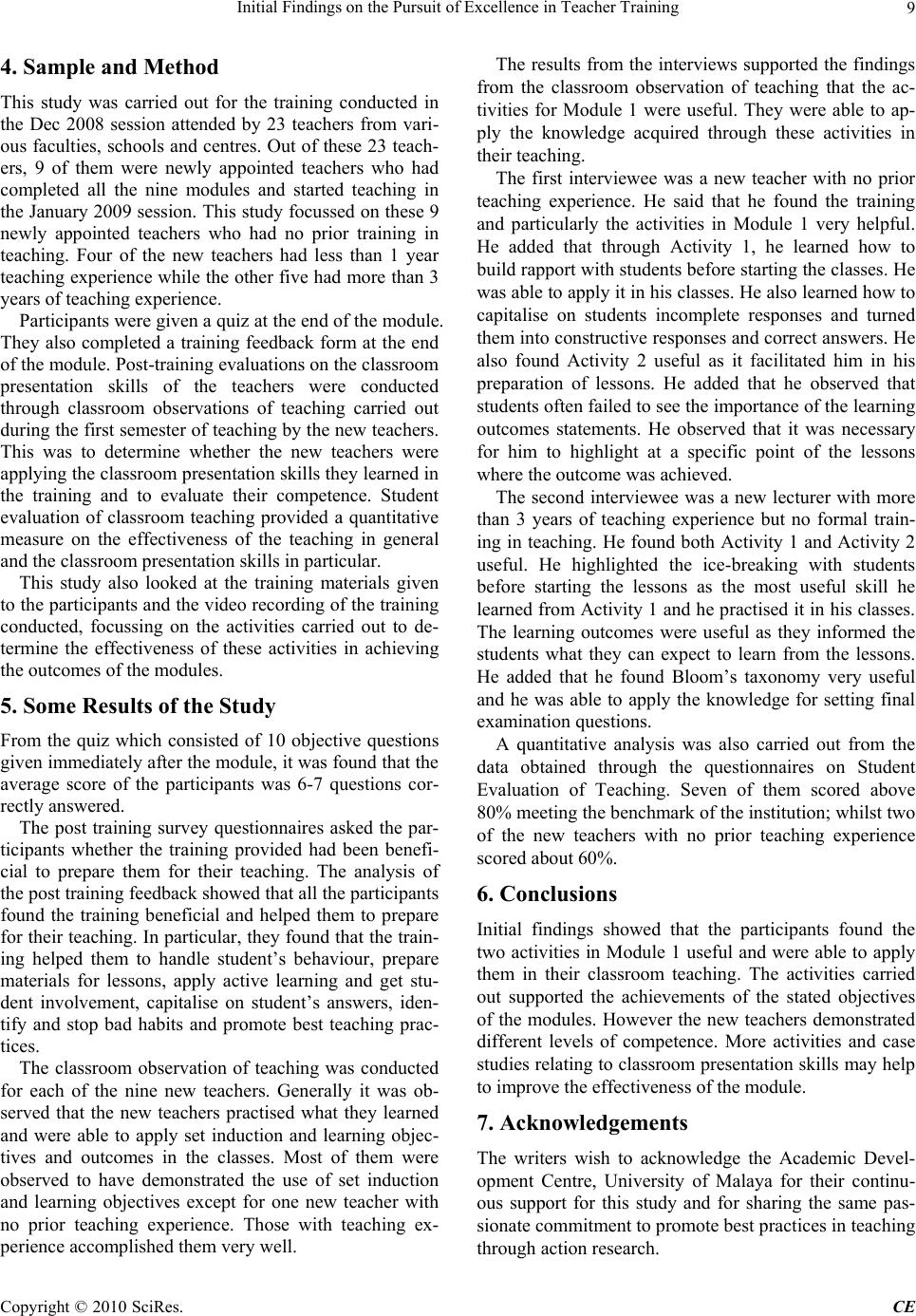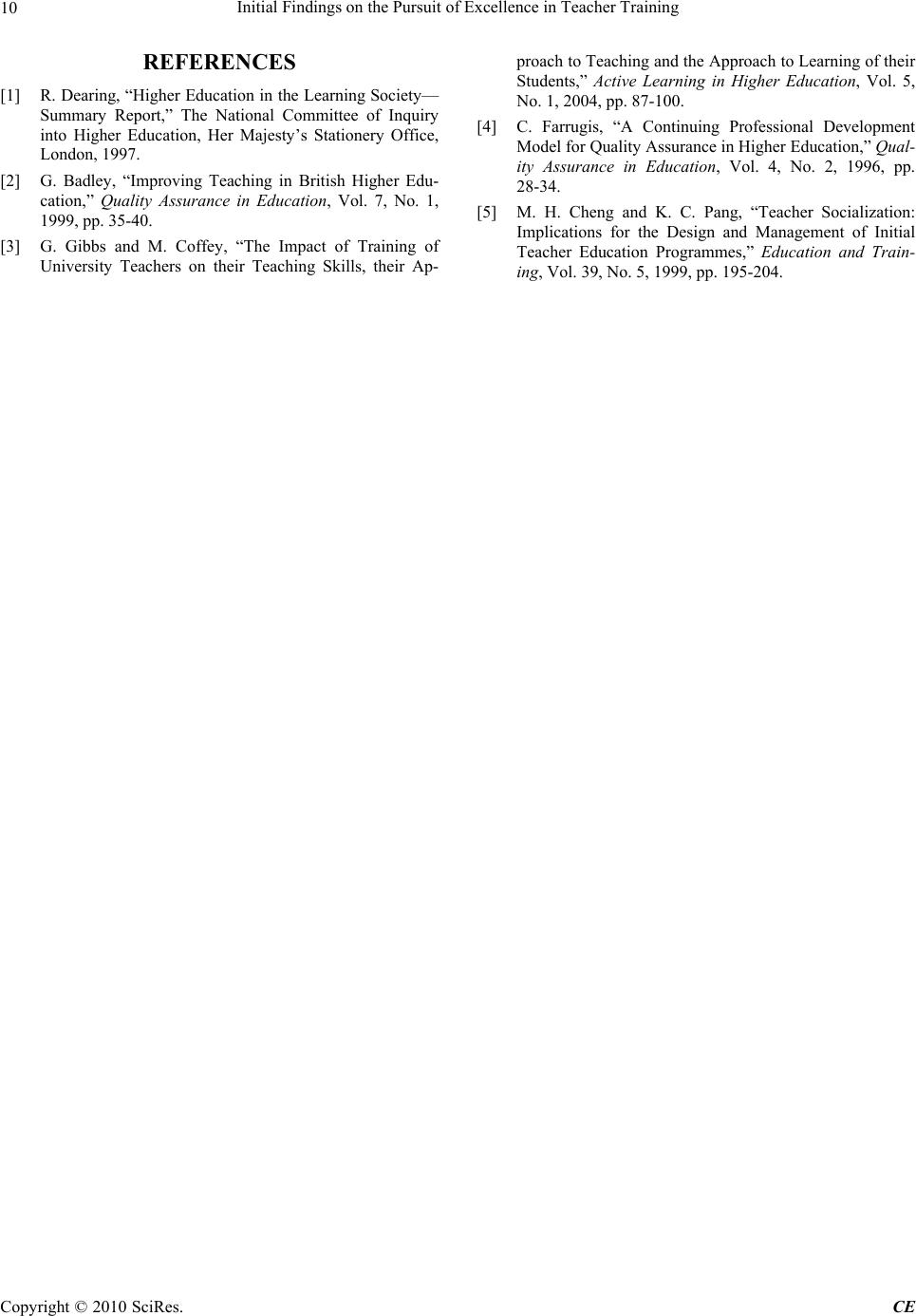Paper Menu >>
Journal Menu >>
 Creative Education, 2010, 1, 7-10 doi:10.4236/ce.2010.11002 Published Online June 2010 (http://www.SciRP.org/journal/ce) Copyright © 2010 SciRes. CE 7 Initial Findings on the Pursuit of Excellence in Teacher Training Sor Heoh Saw Office of Teaching and Learning, INTI International University, Nilai, Malaysia. Email: sorheoh.saw@newinti.edu.my Received December 30th, 2009; revised March 2nd, 2010; accepted April 5th, 2010. ABSTRACT This article reports the initial findings of a study carried out to evaluate the effectiveness of an academic skills training programme that prepares new university college teachers for teaching. Videotaped recordings of training, classroom observation of teaching and student evaluation of teaching were carried out and the results were analyzed to evaluate the effectiveness of the delivery and the activities for one of the module in achieving the stated objectives of the module. New teachers found the two activities in the Module 1 useful and were able to apply what they learned through these activities in their classroom teaching. The activities carried out supported the achievements of the intended outcomes of the module. However the new teachers demonstrated different levels of competence. Keywords: Teachers Training, Higher Education 1. Introduction Since Dearing’s Report [1] universities in UK have ac- knowledged the importance of preparing new teaching staff with basic teaching skills as part of the quality as- surance for teaching and learning. The commitment of the institutions is demonstrated by the setting up of units responsible for ensuring quality teaching and learning [2]. These units conduct training on teaching and learning, promote good practices and carry out research in teach- ing and learning. Studies carried out [3] have reported evidence of a range of positive changes in university teachers in the training group, and in their students, and a contrasting lack of change, or negative changes, in un- trained teachers from the control group. Many institutions of higher learning in Malaysia have collaborative ar- rangements with UK universities to franchise their de- gree programmes. Likewise, these institutions are ex- pected to provide training to their new teachers. They have also set up units to provide initial training to new teachers and more advanced trainings in specific areas relating to teaching and learning [4]. 2. Description of the Programme The Academic Skills Training programme consists of nine modules. The topics covered by these modules are classroom presentation skills, teaching methods and techniques, teaching and learning theories, assessment and evaluation, and microteaching. All newly appointed teachers are required to attend and complete the Aca- demic Skills Training Programme before they commence teaching. Those with formal training and qualification in teaching can apply to be exempted from the programme. The objectives for each of the nine modules in the programme are: 1)Classroom Presentation Skills—Module 1 Participants will learn how to start a lesson effectively using set induction. To guide the teachers and the stu- dents in a lecture, clear and precise instructional objec- tives are needed. Participants will also learn that to teach well in a class, they have to plan their instructional events that include the teaching media needed to bring the message across to the students. 2) Classroom Presentation Skills—Module 2 PowerPoint can be an effective instructional medium if the teachers know how to tap into its power. This module also touches on how to search for useful information in the Internet and use it to support classroom teaching. Participants are also introduced to the use of Learning Management System in supporting teaching and learning. 3) Teaching Method and Techniques—Module 3 and Module 4 Participants will learn the importance of active learn- ing and ways to implement active learning in their classes. The process of active learning is then related to some of the common teaching methods currently used  Initial Findings on the Pursuit of Excellence in Teacher Training 8 such as small group discussions, lectures, brainstorming and tutorials. The important technique of questioning effectively is discussed with emphasis placed on wait times and the use of different levels and types of ques- tions in relation to Bloom’s taxonomy. 4) Teaching and Learning Theories—Module 5 Participants will learn how the theories of behaviour- ism, cognitivism and constructivism help in the under- standing of the process of learning, and their implications to teaching. The theory of multiple intelligences and its relationship to learning styles is examined with regard to implications to the teaching and learning situations. Par- ticipants will be able to relate the ideas gained from the learning theories as important guides in the structuring and implementation of effective teaching methods. 5) Assessment and Evaluation—Module 6 and Module 7 Participants will learn how to use the marking scheme to ensure fair assessment of learning outcomes. Assess- ment can also be used to support and improve teaching. They will also learn how to set the various types of test questions and new assessment methods such as perform- ance assessment and portfolio assessment. 6) Outcome-based Education—Module 8 Participants will be introduced to outcome based edu- cation, distinguishing it from the current education. They will learn how to redesign the current contents, instruc- tional strategies and assessment in line with outcome based education. The module also discusses its advan- tages and challenges. 7) Microteaching—Module 9 Participants are assigned into groups. Each group con- sists of between 8-10 participants. Each participant is allocated 15 minutes in a microteaching session which is videotaped. The group will view the videotape together with the trainer as facilitator. The aim is to learn from each other and not to criticise. The participants will comment on their own teaching in particular their strong points. The other participants are welcomed to give their suggestions. 3. About this Study This study was carried out on Module 1 which is on classroom presentation skills. The duration of the module is 3 hours and it is delivered using a combination of lec- tures, video screenings and activities. Information on the module including the objectives, activities and teaching and learning strategies are presented in Table 1. Table 1. Module 1 – classroom presentation skills: module information, objectives, activities, teaching & learning strategies Module Title Classroom Presentation Skills Module Outcomes Participants will acquire the knowledge on: 1) how to start a lesson, 2) how to write learning objectives and outcomes, and 3) how to conduct lesson effectively. Module Duration 3 hours Mode of Delivery Lectures, mock classroom presentation, discussions, video, activities No Objectives Activities Teaching & Learning Strategies 1 Define set induction. Use them confidently to catch students’ attention when you start a class. How to handle a class? 1) Get a volunteer to teach for 20 minutes while another 5 volunteers are to act the roles of students who talk in the class, sleep in the class; answer call from mobile phone; ask questions and challenge the lecturer’s answers and do not respond to undirected questions. 2) Discuss how the volunteer handles the class 1) Classroom Presentation by a volunteer 2) Discussion of Classroom Presentation by volunteer 3) Video on Presentation using Set induc- tion 4) Lectures and discussions 2 Define advance organizers. Use them confidently to catch students’ attention when you start a class. None Lecture and discussions 3 Distinguish between learning objectives and learning outcomes. Write your learning objectives and learning outcomes for each of your lessons so that students know exactly what they are ex- pected to learn in your lesson. Writing Learning Objectives and Outcomes Each group is given one level of the Bloom taxonomy. The group members are to produce one learn- ing objective and the required number of learning outcomes. 1) Lecture and discussion 2) Review of Written Learning Objec- tives and Outcomes from the group. 3) Elicit suggestions from participants and provide suggestions for improving the written learning objectives and outcomes. 4 Describe Gagne’s instructional event. Decide when to use any specific events in your lesson in order to deliver your lessons effectively to the students. None Lecture and discussion Copyright © 2010 SciRes. CE  Initial Findings on the Pursuit of Excellence in Teacher Training9 4. Sample and Method This study was carried out for the training conducted in the Dec 2008 session attended by 23 teachers from vari- ous faculties, schools and centres. Out of these 23 teach- ers, 9 of them were newly appointed teachers who had completed all the nine modules and started teaching in the January 2009 session. This study focussed on these 9 newly appointed teachers who had no prior training in teaching. Four of the new teachers had less than 1 year teaching experience while the other five had more than 3 years of teaching experience. Participants were given a quiz at the end of the module. They also completed a training feedback form at the end of the module. Post-training evaluations on the classroom presentation skills of the teachers were conducted through classroom observations of teaching carried out during the first semester of teaching by the new teachers. This was to determine whether the new teachers were applying the classroom presentation skills they learned in the training and to evaluate their competence. Student evaluation of classroom teaching provided a quantitative measure on the effectiveness of the teaching in general and the classroom presentation skills in particular. This study also looked at the training materials given to the participants and the video recording of the training conducted, focussing on the activities carried out to de- termine the effectiveness of these activities in achieving the outcomes of the modules. 5. Some Results of the Study From the quiz which consisted of 10 objective questions given immediately after the module, it was found that the average score of the participants was 6-7 questions cor- rectly answered. The post training survey questionnaires asked the par- ticipants whether the training provided had been benefi- cial to prepare them for their teaching. The analysis of the post training feedback showed that all the participants found the training beneficial and helped them to prepare for their teaching. In particular, they found that the train- ing helped them to handle student’s behaviour, prepare materials for lessons, apply active learning and get stu- dent involvement, capitalise on student’s answers, iden- tify and stop bad habits and promote best teaching prac- tices. The classroom observation of teaching was conducted for each of the nine new teachers. Generally it was ob- served that the new teachers practised what they learned and were able to apply set induction and learning objec- tives and outcomes in the classes. Most of them were observed to have demonstrated the use of set induction and learning objectives except for one new teacher with no prior teaching experience. Those with teaching ex- perience accomplished them very well. The results from the interviews supported the findings from the classroom observation of teaching that the ac- tivities for Module 1 were useful. They were able to ap- ply the knowledge acquired through these activities in their teaching. The first interviewee was a new teacher with no prior teaching experience. He said that he found the training and particularly the activities in Module 1 very helpful. He added that through Activity 1, he learned how to build rapport with students before starting the classes. He was able to apply it in his classes. He also learned how to capitalise on students incomplete responses and turned them into constructive responses and correct answers. He also found Activity 2 useful as it facilitated him in his preparation of lessons. He added that he observed that students often failed to see the importance of the learning outcomes statements. He observed that it was necessary for him to highlight at a specific point of the lessons where the outcome was achieved. The second interviewee was a new lecturer with more than 3 years of teaching experience but no formal train- ing in teaching. He found both Activity 1 and Activity 2 useful. He highlighted the ice-breaking with students before starting the lessons as the most useful skill he learned from Activity 1 and he practised it in his classes. The learning outcomes were useful as they informed the students what they can expect to learn from the lessons. He added that he found Bloom’s taxonomy very useful and he was able to apply the knowledge for setting final examination questions. A quantitative analysis was also carried out from the data obtained through the questionnaires on Student Evaluation of Teaching. Seven of them scored above 80% meeting the benchmark of the institution; whilst two of the new teachers with no prior teaching experience scored about 60%. 6. Conclusions Initial findings showed that the participants found the two activities in Module 1 useful and were able to apply them in their classroom teaching. The activities carried out supported the achievements of the stated objectives of the modules. However the new teachers demonstrated different levels of competence. More activities and case studies relating to classroom presentation skills may help to improve the effectiveness of the module. 7. Acknowledgements The writers wish to acknowledge the Academic Devel- opment Centre, University of Malaya for their continu- ous support for this study and for sharing the same pas- sionate commitment to promote best practices in teaching through action research. Copyright © 2010 SciRes. CE  Initial Findings on the Pursuit of Excellence in Teacher Training 10 REFERENCES [1] R. Dearing, “Higher Education in the Learning Society— Summary Report,” The National Committee of Inquiry into Higher Education, Her Majesty’s Stationery Office, London, 1997. [2] G. Badley, “Improving Teaching in British Higher Edu- cation,” Quality Assurance in Education, Vol. 7, No. 1, 1999, pp. 35-40. [3] G. Gibbs and M. Coffey, “The Impact of Training of University Teachers on their Teaching Skills, their Ap- proach to Teaching and the Approach to Learning of their Students,” Active Learning in Higher Education, Vol. 5, No. 1, 2004, pp. 87-100. [4] C. Farrugis, “A Continuing Professional Development Model for Quality Assurance in Higher Education,” Qual- ity Assurance in Education, Vol. 4, No. 2, 1996, pp. 28-34. [5] M. H. Cheng and K. C. Pang, “Teacher Socialization: Implications for the Design and Management of Initial Teacher Education Programmes,” Education and Train- ing, Vol. 39, No. 5, 1999, pp. 195-204. Copyright © 2010 SciRes. CE |

